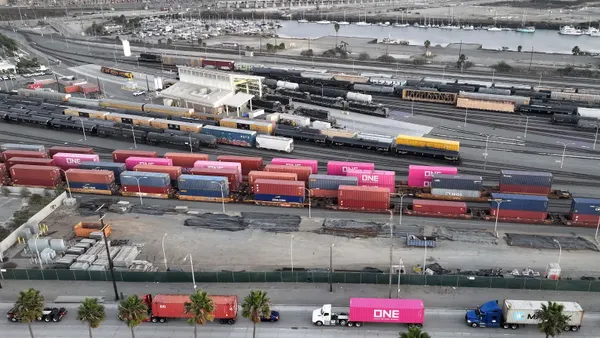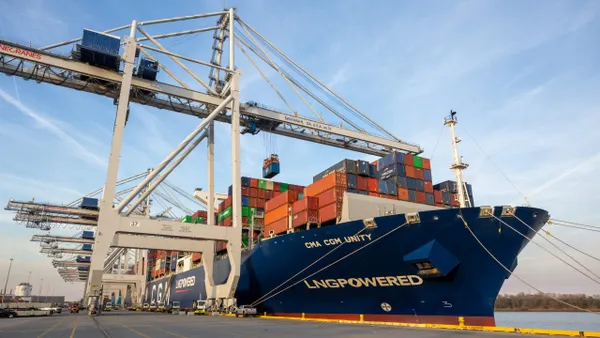Three weeks ago, ocean carriers began contacting shippers to let them know another COVID-19 outbreak was impacting supply chains.
"A number of COVID-19 cases had emerged at the [Yantian International Container Terminal] last week, and tightened health and safety measures have been rolled out by local authorities," MSC said in a June 2 customer advisory about the port in Shenzhen, China.
In a more recent update, Maersk said operations at the port are set to improve as workers return. But issues are expected to remain.
"While this has a positive impact on gate activity, which is soon expected to reach the same levels as before the incident, schedule reliability will continue to suffer with an average waiting time of 16 days and counting," Maersk wrote to customers Monday.
Local authorities are trying to stop the spread of the Alpha variant after a port worker tested positive for the coronavirus on May 21. The port had been operating at 30% of its capacity. Operations have now returned to 70% capacity, according to Florian Braun, Head of Ocean, EMEA at Flexport. Full operations are expected to resume later this month, according to the state-run China Daily. There are already signs that operations have begun to normalize with waiting time dropping over the last two weeks, though its still elevated, according to emailed figures from Drewry.
"Still a huge backlog stocked up due to a drop in capacity to 30% in the last weeks," Braun said in an emailed statement.
Drewry said it has already resulted in an uptick in rates on major East-West trade lanes, which could spread to other lanes over time.
"In addition, the overall surge in transport cost may causes shortages of goods across the world, and trigger inflation," Hind Chitty, Principal Consultant at Drewry Supply Chains Advisory, said in an emailed statement.
Yantian is part of the third busiest gateway in the world
The safety measures have dramatically limited throughput at one of the world's largest ocean gateways. Yantian alone handled 13.3 million TEUs in 2020, according to Flexport. For comparison, The Port of Los Angeles — the largest port in the U.S. — carried 9.2 million TEUs in the same year, according to the port's figures.
Loading dwell more than doubled
The port's lowered operating capacity has slowed loading and discharging of cargo from vessels at Yantian.
"Dwell loading times have increased 122% in the last two weeks, while dwell departure times [increased] 242% during the same time period," FourKites said in a June 15 note on the port.
Discharge dwell more than tripled
The backups at the port have resulted in a buildup of exports in the container gateway. By one estimate, about 300,000 TEUs are at the facility waiting to be exported, according to CNBC reporting from last week.
The stacks of containers built up has led to availability issues with reefer plugs. Carriers, including ONE and CMA CGM, have implemented reefer surcharges due to the congestion. CMA CGM's surcharge is listed as $1,250 per reefer container, telling its customers that "most reefer plugs [are] already being occupied" at Yantian.
Port closures lead to anchorage backups
As the port's operations have slowed, ships at anchor have had to wait for longer.
Figures from Spire show that the number of ships at anchor has averaged about 20 throughout June. On June 16, Spire noted a 72% decline in port traffic compared to the previous week and a 99% increase in waiting times over the same period.
The number of ships waiting to call the port could be much greater, as vessels await in the South China Sea or make their way toward Yantian. A Hapag-Lloyd spokesperson told The Wall Street Journal that about 50 ships are waiting to call in at Yantian.

"We still could see up to 67 Container vessels waiting in South China to get a berthing window for Nansha and Shekou," Braun said.
As carriers warned customers about Yantian, it often came with news of canceled sailings for the port facility. This means that an ocean market already low on capacity is losing valuable room for cargo.
Blank sailings surge in June
Maersk alone noted this week that 19 of its sailings would be impacted by the continued issues at Yantian. Hapag-Lloyd announced more than a dozen sailings that were impacted.
"Over the period of June 1 to June 15, 298 container vessels with a combined total capacity of over three million TEUs skipped the port, a 300-percent increase in blank sailings in one month," project44 said in a note last week.
Hapag-Lloyd said it had diverted sailings to the nearby Nansha and Hong Kong. Drewry's figures show that as wait time has begun to ease in Yantian, it has surged in Hong Kong due to these diversions over the last three weeks, Chitty said.
Blank sailings take capacity out of service
The uptick in blank sailings for Yantian means that exports are being left behind as capacity is taken out of the system. A note from project44 said the backlog could take weeks to work through even "in this best-case scenario."
And it came less than three months after the blockage of the Suez, during an environment in which schedule reliability for ocean carriers is already near record lows and rates are already surging for shippers.
"Even shipments not directly impacted by the Yantian situation could feel the impact, as carriers adjust their networks to avoid congestion at YICT," Vice President of Marketing at project44 Josh Brazil said in a statement.
All of this disruption is happening at a time when shippers are starting to plan for peak season.
"It is impacting all clients through all segments as Summer is also the traditional time to import Christmas / Seasonal goods," Braun said, adding that one "solution is to make sure shippers are also fully loading every container ... The carriers might not be able to fit more containers on their ships, but shippers can fit a lot more inventory in their containers if they pack them smartly!"
But for some it's just too much.
"Some of the small shippers/importers are even cancelling their orders, as the exorbitant cost of transport, cannot be sustained any more," Chitty said.














